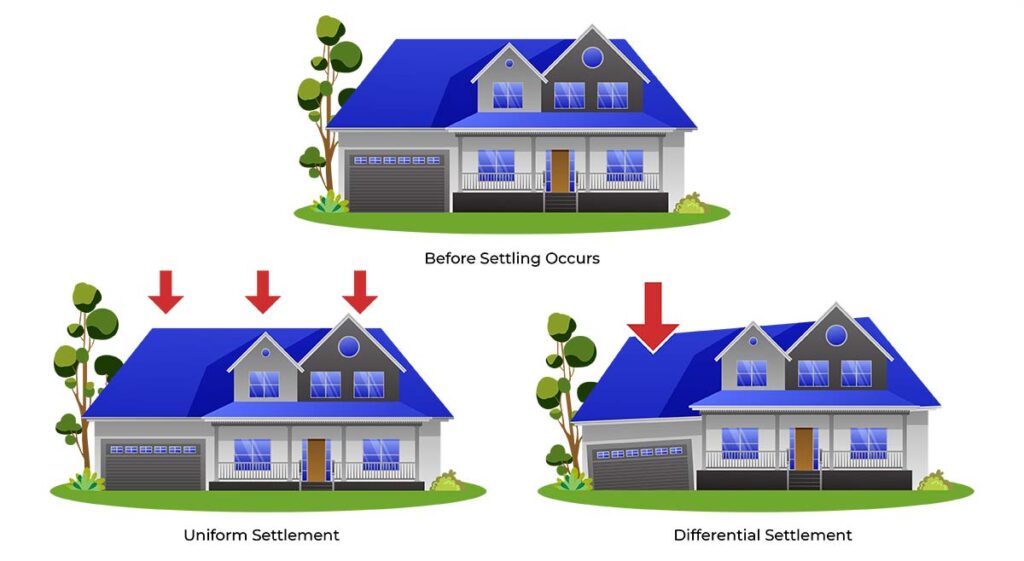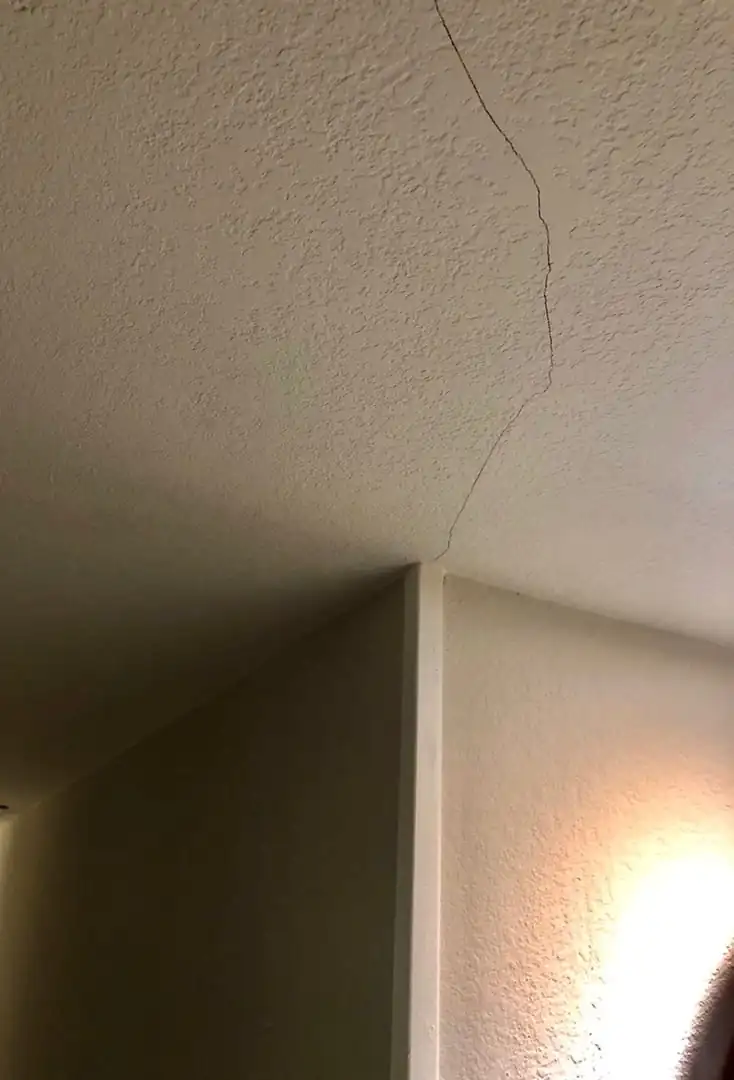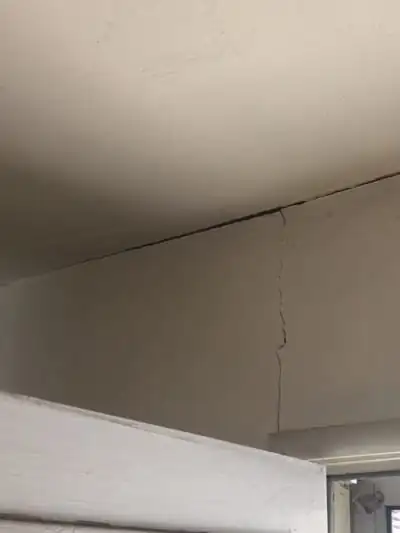Looking for information on ceiling cracks and when to worry? If so, don’t hit that back button because you’ve landed on the right page. In this article, we will go over dangerous and non-dangerous ceiling cracks, when you should worry about a ceiling crack, what causes ceiling cracks, how to prevent ceiling cracks, and more.
Are ceiling cracks always serious?
The good news is ceiling cracks aren’t always serious. Sometimes, they’re just ugly. Whether or not ceiling cracks are structurally significant (that means they’re serious) depends on the crack’s location, size, and type. Older homes are more likely to have ceiling cracks. Examples of ceiling cracks that aren’t structurally significant and shouldn’t cause you to worry include,
- Spiderweb cracks – These are usually caused by paint build-up after many years and obviously more common in older homes.
- Straight cracks Most of the time, straight cracks are caused by improper drywall installation. When not enough drywall mud is used, the tape can pull away, creating what looks like a ceiling crack.
Even though a crack might not appear structurally significant, keep an eye on it anyway to make sure it’s not getting bigger. If it does start to get bigger, contact a professional right away. Foundation problems worsen over time and will cost more money to repair if you wait.
Ceiling Cracks, When To Worry
Homeowners should learn the warning signs of a structural ceiling crack so that if they see one, they will know to contact a foundation repair contractor right away. Here are some ceiling cracks that should cause you to worry because they indicate structural damage:
Any ceiling crack accompanied by sagging
When there’s cracking along with sagging, that’s a sign there’s a serious structural problem. Contact a professional immediately.
A ceiling crack that goes across the ceiling and down a wall
A cluster of many small ceiling cracks
Any ceiling crack that’s wider than 1/8 inch
Cracks that run diagonally across the ceiling
It takes a lot of force to rip through drywall this way. Foundation movement is the likely cause.
Ceiling cracks with discoloration
Discolored ceiling cracks indicate water is involved. Is there a bathroom above the ceiling?
A gap between the wall and the ceiling
Although this isn’t technically a ceiling crack, it is a sign of foundation movement.
The above cracks are likely caused by foundation settlement, and if you see any, you should contact a foundation repair contractor and ask for an inspection. Most foundation repair contractors will perform a free inspection and then give you a repair estimate.
You can also contact a structural engineer and ask for an inspection. They will write up a report that you can give to the foundation repair contractor. Keep in mind, though, that structural engineers always charge for a foundation inspection.
For more information see, Why Foundation Cracks Happen.
Ceiling cracks are caused by various things including,
What Causes Ceiling Cracks?
Foundation settlement
Foundation settlement is when a foundation settles into the soil unevenly. The graphic below illustrates the difference between uniform settlement (which happens to all structures after they’re built) and differential settlement.
Paint build-up
These types of ceiling cracks are more common in older homes because there’s more paint on the ceiling.
Water leaks
These ceiling cracks are accompanied by discoloration. Is there a problem with your roof? Has it been raining recently? Is there a bathroom over the ceiling?
Structural damage
This is mainly caused by differential settlement, which means the house is gradually sinking into the soil unevenly. Differential settlement puts a lot of stress on a foundation and can cause structural damage.
Something heavy on the floor above the ceiling
Is there a bathtub or a piano on the floor above the ceiling?
Your drywall wasn’t installed properly
Improperly taped drywall joints can cause the tape to come loose, creating a straight crack.
Natural disasters like hurricanes and floods.
(Depending on where you live, ceiling cracks can also be caused by earthquakes, sinkholes, etc.)

What To Do If You See Suspicious Ceiling Cracks
If you see suspicious ceiling cracks, you should immediately contact a foundation repair professional or structural engineer and ask for an inspection. Problems caught early will save you money in repair costs.
Other Signs Of Foundation Trouble
If you see any of the ceiling cracks mentioned in the previous section, look around for other signs of foundation trouble. These include:
Doors and windows that don’t open and close properly
Uneven floors
If you drop something round on the floor does it always roll toward one area?
Floor cracks
Look for cracks that span the length of the room, wall to wall. Floor cracks limited to one or two tiles were probably caused when something heavy fell on the floor.
Cracked walls
Horizontal cracks are the most problematic. Vertical cracks in a basement wall are usually caused by concrete shrinkage during the curing process. While they can allow water to seep into your basement, they don’t threaten the home’s structural integrity.
Bowed basement walls
This is caused by the build-up of hydrostatic pressure in the soil around the foundation. Hydrostatic pressure builds up due to poor drainage.
Moldings that have separated from the wall or ceiling
Even slight separations should cause concern.
Wrinkled or torn wallpaper
The wall behind the wallpaper might be cracked.
Stair step cracks in brick or masonry
This is a sure sign of foundation damage.
Leaning porches and chimneys
Sometimes, the problem is with the foundation under the porch or chimney. However, the problem could also be caused by the home’s foundation.
Wet basement
A wet basement could mean cracks in the foundation wall. These might be non-structural cracks, but they could also be structural.
Things Homeowners Can Do To Prevent Foundation Problems
Most foundation problems – including some ceiling cracks – are caused by differential settlement, and differential settlement is mainly caused by poor drainage around the foundation. Therefore, you can prevent foundation trouble by getting groundwater under control. Here are a few ways to do that:
Ensure the yard around your home slopes away from the foundation
If the yard slopes toward the foundation, water will pool around the foundation.
Clean your gutters regularly
If your gutters are clogged, water will flow over the side of the home into the soil around the foundation.
Install an underground downspout and bubbler pot
Water from the gutters flows into the underground downspout and gets channeled toward the bubbler pot (also referred to as a pop-up emitter) situated several feet from your foundation. When the bubbler pot is full of water, it pops up and ejects the water away from the foundation.
Don’t plant water-hungry flowers and shrubs near the foundation
When you water them, you’ll just be dumping more water around the foundation.
Keep large trees away from the foundation
Large trees can “drink” moisture from the soil leaving behind voids that the home might sink into.
Install an exterior drainage system
This would include wall parging, a drainage mat, and a dimple board. An exterior drainage system will pull the water away from your home’s foundation and push it – ideally – into an EZ flow or UDE system.
If you have one or more ceiling cracks worrying you and you’re in our service area, contact us today for a free inspection and repair estimate.





















